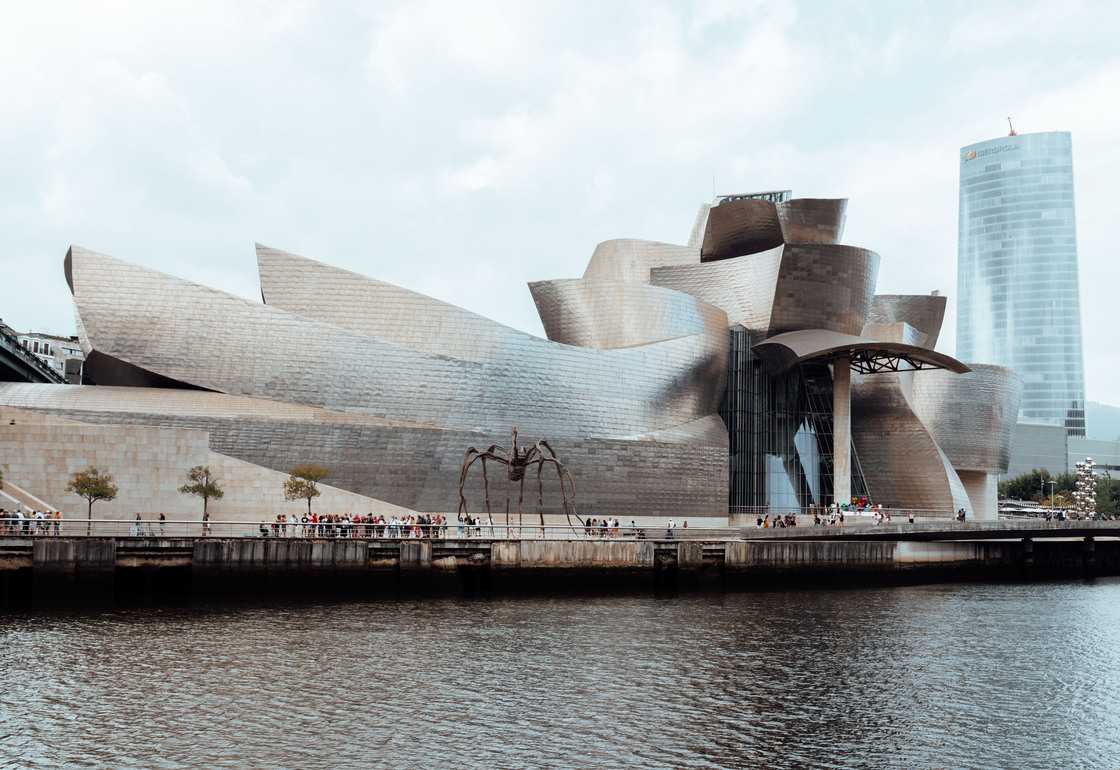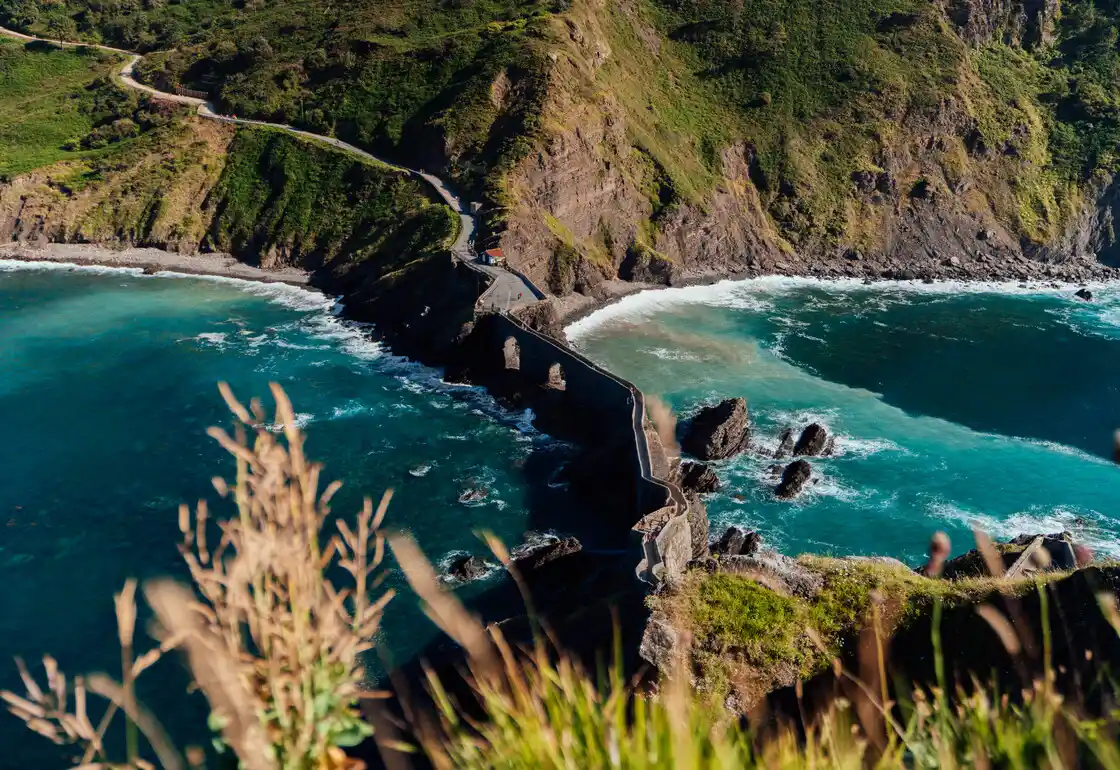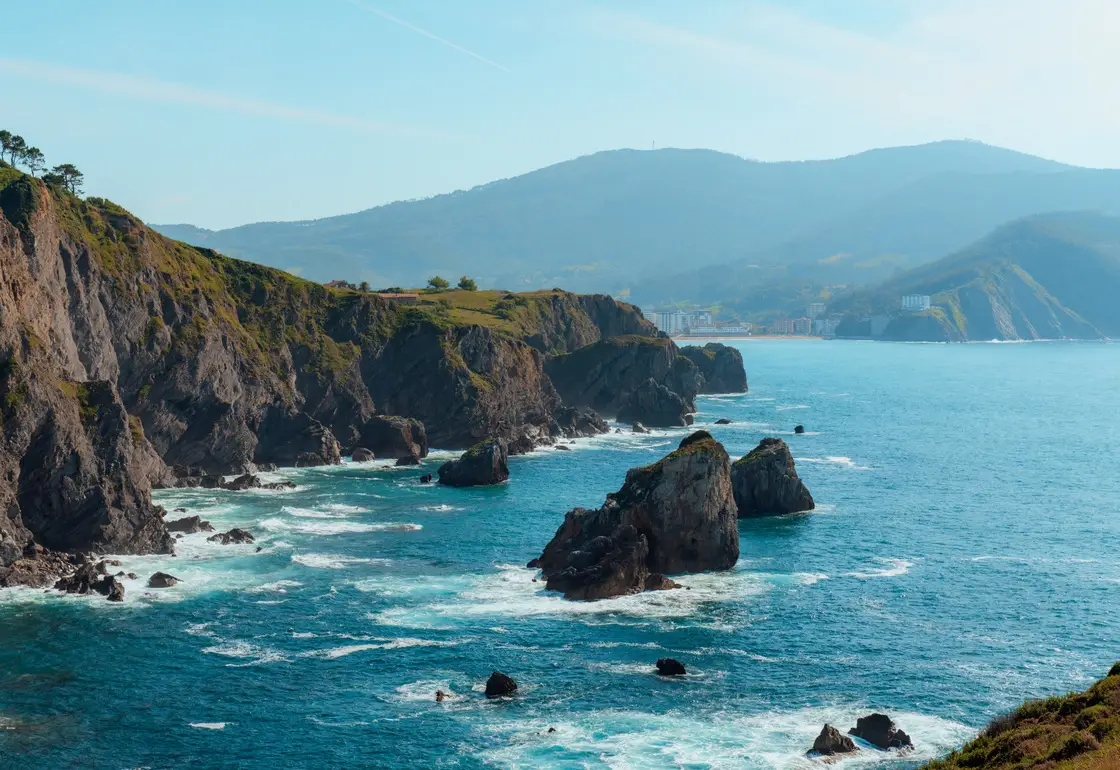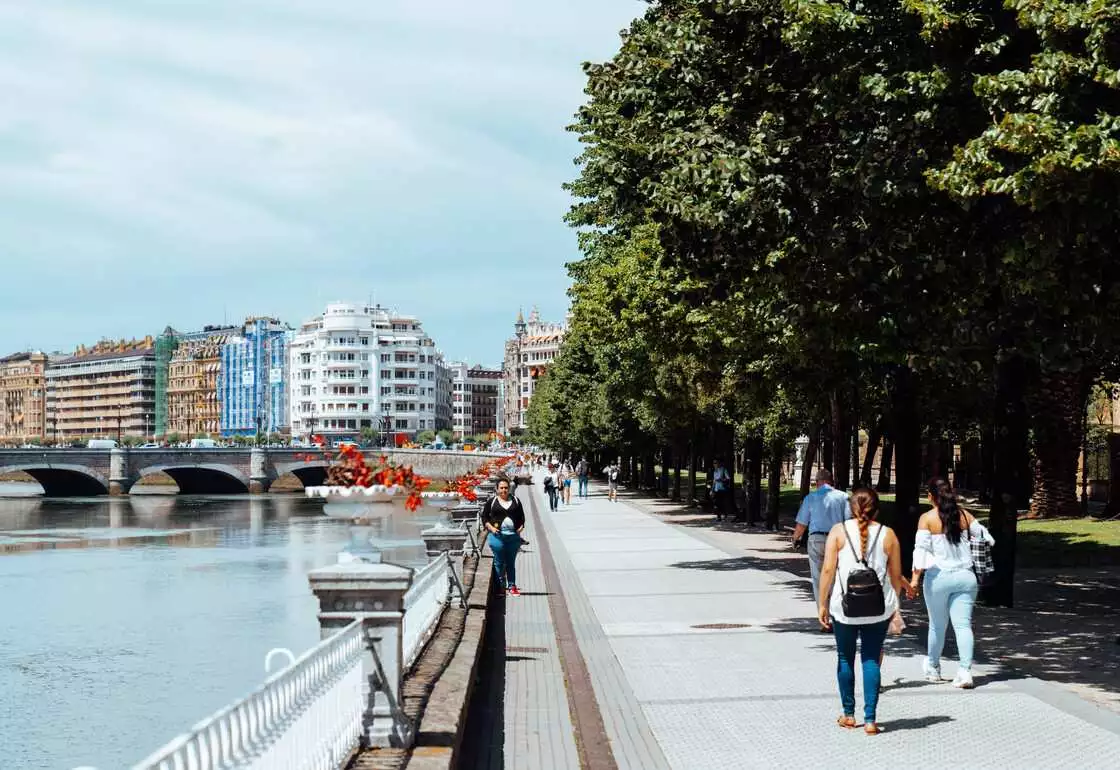📝 ALL BASQUE COUNTRY BLOG POSTS
Things to do in Basque Country
The essence of the Basque Country is unique and very special. Located in the north of Spain, on the east coast of the Bay of Biscay, just as it reaches France, this community has an authenticity of its own that makes it different from all the others.
You can easily travel around it by car since its total extension is 7,234 square kilometers. If you want to do it in parts, you can always choose the coast for a route (246 kilometers) and then go into the interior and its mountains.
Either way, the Basque Country will captivate you, and it will not be your only visit. In this post, I will show you some of the places that I am in love with and to which I return every time I can without hesitation.
1. Bilbao

Bilbao is the most populated city in the Basque Country (346,000 inhabitants); that’s why it has everything you need for a full but pleasant life without hurry but without missing opportunities. I love it; you can visit it on foot, and you find a perfect balance between history, art, culture, style, class, and modernity.
It stretches along the Nervion River and the estuary of Bilbao, and the municipality is flanked by two important mountain ranges of about 400 meters in altitude that provide a great microclimate.
Since it was founded as a city at the end of the 13th century, it has been a key industrial and commercial center (in fact, the blast furnaces of Bilbao were fundamental to its development in Spain). The port that opened essential commercial routes for the country, the blast furnaces, and the industry made this city one of the richest in Spain.
Once there, it is best to walk through the old town because it is a beauty and visit essential places such as the Guggenheim Museum, Plaza Nueva, Gran Vía, the Church of San Antón, the Bizkaia Bridge, Plaza Moya, the Basilica of Bego, or the Doa Casilda Park.
If the weather is good, take the opportunity to walk along the estuary and contemplate the buildings and the wonderful architecture of the area.
In this article on visiting Bilbao for a day, you’ll discover the city’s must-see places. If you have more time, our two-day Bilbao itinerary will be perfect for you. Planning to use Bilbao as your base during your trip? Don’t miss our tips on where to stay in Bilbao.
If you are staying in Bilbao and want to visit other places in the Basque Country, check out the best day trips from Bilbao.
🎟️ If you want to get to know the city better, you will love this free tour of the city, you’ll love it.
2. San Juan de Gaztelugatxe

If you have seen the famous Game of Thrones series, you will surely want to see this impressive place, San Juan de Gaztelugatxe (or Rocadragon in fiction), an obligatory stop on the route through the Basque Country.
Located 35 kilometers from Bilbao, nature did an exceptional job in building this cone-shaped islet 150 meters high above sea level, on which stands a chapel dedicated to San Juan Bautista.
The effort will be worth it, because in order to reach the top of the islet and the chapel, you will have to walk along a narrow path and climb 241 steps. Once at the top, be sure to visit the inside of the chapel, which also has a key significance for the fishermen of Bermeo and the area. Inside are all kinds of offerings that the fishermen leave before their long trips to the sea.
Depending on the day of your visit, you will have to get a reservation ticket or not. This is the case on days with restricted access (summer months, holidays, and some weekends). You must make a reservation on this official website.
3. Hondarribia, one of the most beautiful villages in Spain

I loved Hondarribia, even though it was pouring rain in the middle of July. It is so charming, beautiful, and bursting with Basque culture… I was fascinated. It is the best-preserved walled city in Basque Country, and its cobbled streets will make you travel back in time.
Maybe in some places, you can still find it as Fuenterrabía, but nowadays its official name is Hondarribia, or Hondarribi as the locals call it.
Located on the left bank of the mouth of the Bidasoa (right on the sea), it exudes a unique seafaring spirit that truly captivates me. It perfectly combines sea and mountain, which is reflected in its culture and delicious gastronomy (its reputation is unmatched, so I recommend you stop here to eat). Just strolling through the old town, you will see taverns, local stores, and restaurants that will make your mouth water.
Stroll along Calle Mayor, and you will want to stay in its buildings with wooden balconies. Visit the Puerta de Santa Maria, admire the City Hall building, and add a visit to the house of Zuloaga (now a library) and the Casadevante Palace. Everything is so picturesque.
4. Sopelana, beach and relaxation near Bilbao


If there is a place in the Basque Country that has stolen my heart over the past four years, it is undoubtedly Sopelana. I discovered it during the summer of the pandemic, alone, seeking to heal from a sentimental separation. Sopelana welcomed me so warmly that I have returned three times since then.
Sopelana is one of the closest coastal towns to Bilbao (towards France), only 20 kilometers away, and very well connected to the city by subway. The town’s best features are its beaches, including La Salvaje, and its strong surfing culture. Surfing enthusiasts, who have their own distinct lifestyle, find Sopelana a wonderful refuge. In fact, friends from Bilbao often use it as a reference beach to “catch waves” every morning before work.
Additionally, the town is very pretty, small, quiet, and very enjoyable. During my last stay there in April, I embraced village life and found a nice cafe with delicious products, perfect for setting up a brunch on a sunny terrace—ideal for reading and relaxing. The cafe is called Goxo Break.
If you are looking for a place to stay in Sopelana, the best choice is undoubtedly Moana Eco Surf.
5. Urdaibai Biosphere Reserve

The natural scenery of the Basque Country is so spectacular that you can even visit and enjoy unique Biosphere Reserve sites such as the Urdaibai estuary, a natural area formed by the mouth of the Oca River in the Bizkaia region of Busturialdea.
With an area of 220 square kilometers, the spectacular ecological wealth has given it the opportunity to be qualified as a biosphere reserve in 1984. Although its official name is Urdaibai Biosphere Reserve, it is also known as the Mundaca or Guernica estuary.
It is the most important wetland in the Basque Country, and it is home to countless species of flora and fauna, being an important resting area for migratory birds. The best thing to do is to visit it and enjoy a pleasant route through its grounds, always respecting its ecosystem and taking the utmost care of it.
6. The Flysch of Zumaia, best things to do in Basque Country

When it comes to nature, the Basque Country is a great place to connect with and discover unique and spectacular places. With that premise, we arrive at the Flysch of Zumaia, one of the most spectacular places in Basque Country.
This geopark is a small territory on the Cantabrian coast, surrounded by the Basque mountains, where the municipalities of Zumaia, Deba, and Mutriku all meet. It is a place where the green of the pastures and forests merges with the intense blue of the Cantabrian Sea.
In addition to its visible beauty, the geopark holds a unique secret: the flysch, formed by layers of rock dating back 60 million years. Spanning 13 kilometers of cliffs, the flysch allows us to analyze the geological evolution of the area.
To visit the Flysch, you can choose between a walking route along the cliffs or a boat trip to see them from the sea. The easiest way is to go to Zumaia and view them from the Hermitage of San Telmo or Itzurun Beach.
7. San Sebastian, capital of Guipuzcoa

The capital of the province of Guipuzcoa, San Sebastian, is one of those stately cities that seem to be taken out of a fairy tale, transporting you to another era in a matter of seconds.
Only 20 kilometers from the French border, San Sebastian exudes a blend of French essence while maintaining its own personality and authenticity. With a perfect population density for a medium-sized city—187,000 inhabitants—San Sebastian lives in harmony with a unique rhythm. This rhythm is said to be the last remnant of the Belle Époque, a historical period that left behind the palaces of the Spanish bourgeoisie who chose this coast for their summer retreats.
There are many must-see places in San Sebastian, such as the Miramar Palace, Ondarreta Beach, the funicular of Mount Igueldo (offering a view of the entire bay), the Cathedral of the Good Shepherd, the magnificent City Hall building, the Basilica of Santa Maria del Coro, the San Telmo Museum, and, of course, the grand promenade along La Concha Beach.
For food lovers, San Sebastian is a culinary temple. Immerse yourself in the pintxo culture by going from bar to bar, discovering the most daring and delicious local creations.
If you plan to visit San Sebastian during your trip to the Basque Country, itineraries like San Sebastian in 2 days or San Sebastian in 3 days will be very useful. And if you decide to make this city your base, check out the post on where to stay in San Sebastian to find the best areas.
🎟️ If you want to get to know the city better, you will love this free tour of the city, you’ll love it.
8. Sanctuary of Arantzazu

You don’t have to be a devotee or a believer to reach this interesting spot in the Basque Country. The Sanctuary of Arantzazu is an imposing architectural complex located in the municipality of Oñate that belongs to the church and where the Virgin of Aránzazu, patron saint of the province, is venerated since, according to legend, she appeared here in 1468.
Some of its peculiarities that make it spectacular are that it is located 750 meters above sea level, in a unique setting, surrounded by mountains and vegetation. It has been cared for by Franciscan monks since 1514, and its basilica, dating from 1950, is such a remarkable sculptural, architectural, and artistic work that it attracts artists from all over the world.
There you can visit the sanctuary and also the caves and the salt museum. It is open from Monday to Sunday from 9:00 a.m. to 7:30 p.m., and admission is free.
9. Getxo


Following our route through the Basque Country, we arrive at Getxo, a small coastal town in Vizcaya, located at the last stretch of the Nervion River, where it becomes the estuary of Bilbao. Thus, it is part of the metropolitan area of Bilbao.
Getxo is home to the Vizcaya Bridge, a UNESCO World Heritage Site since 2006. With 77,770 inhabitants, it is the fifth most populous city in the Basque Country and one of the wealthiest places in Spain, ranking sixth in per capita income in 2019.
The town’s main attractions include its bustling port, the scenic cliffs that surround it, and, within the historic center, the grand palaces of the bourgeoisie from a bygone era and the Galea Lighthouse.
10. Vitoria-Gasteiz, capital of Basque Country

We finish the three major cities of the Basque Country with the capital of the community, Vitoria (also the capital of the province of Alava and the official seat of the Basque Parliament).
It is located at a key point, a crossroads between France and the Spanish Central Plateau, so it has always been strategic militarily, commercially, and culturally from Roman times to the present. It has always held the title of “very noble and very loyal” and has a fair population density with 256,753 inhabitants who love to transmit their essence and culture.
Once in the city, you cannot miss places like the Cathedral of Santa Maria, the Plaza de la Virgen Blanca, the Plaza del Machete, the Plaza de la Burullera, the Green Ring, or stroll through the old town full of history.
In addition, in recent years a new and colorful “attraction” has been added: the route of the murals. Since 2007, artists and locals have been betting on quality urban art by decorating facades with beautiful and impressive murals.
🎟️ If you want to get to know the city better, you will love this this free tour of the city, it’s amazing.
11. Otzarreta beech forest

The Otzarreta beech forest, also known as the magical forest of Gorbeia, is one of the most beautiful places to see in the Basque Country. It is one of the most photographed natural areas in the region, and for good reason. It is described as a natural utopia, where everything seems meticulously designed despite being shaped by the forces of nature.
Upon arrival, fantasy and tranquility take hold of you. The centennial beech trees that coexist around the winding Zubizabala riverbed make this beech forest an enchanting ecosystem, spectacular and worthy of a fairy tale.
Visitors describe it as an authentic visual and auditory spectacle, best experienced with no expectations and an open mind. In spring, the forest is impressive with its intense green foliage, but in autumn, the brown mantle of fallen leaves and the crunching sound underfoot create an unforgettable memory.
12. Getaria, a beautiful town in Basque Country.

Continuing our tour of the small villages in the Basque Country, we come to the renowned and significant village of Getaria. This coastal and seafaring village has always been sustained by fishing, an essence that permeates all its activities.
Getaria is the birthplace of one of Spain’s great sailors, Juan Sebastián Elcano, after whom the Spanish Navy’s training ship is named. But Elcano is not the only notable figure from Getaria. The village also has a rich connection to the world of fashion through the legendary designer Cristóbal Balenciaga, whose class and elegance have left a lasting mark.
In addition to its historical significance, Getaria is famous for its gastronomy, particularly its seafood. Visitors can enjoy fresh, grilled fish in any of the port’s restaurants, always accompanied by the local white wine, Chacolí.
13. Mundaka

One of the world’s longest and best-known surfing spots is Mundaka. You will perfectly comprehend this sentence if you enjoy surfing. I was aware of this wave for a long time, but I must admit that I was completely stunned when I saw it.
The Mundaka is famous in the surfing world for its perfect left wave, which is long and consistent. It begins in the bar of Mundaka and ends on the beach of Laida, reaching 400 meters long and 4 meters high.
But it is not only a great and perfect wave that Mundaka offers (that would be enough). In addition, this small town on the coast of the Cantabrian Sea belonging to the Basque Country offers other very cool points of interest, such as the fishing port, where you will find more than beautiful buildings, such as the casino and the library (which was a pilgrims’ hospital), the Hermitage of Santa Catalina, the old town, or the viewpoint.
14. Bermeo


Bermeo is another of the places to see in the Basque Country that I am very fond of. On that trip in the summer of 2020, the first solo trip in time that helped me heal, Bermeo was one of my stops for lunch and painting. I spent hours sitting on the street painting in my notebook because I thought it was so beautiful. During that time, several people approached me to tell me the history of their town, and it was one of the moments where I perceived more love, respect, and loyalty for the land and place of birth.
The most interesting thing is the port, which is of utmost importance for commercial and international fishing. Here you will find some very cool bars and taverns with terraces where you can enjoy some delicious pinchos.
The town also has a very interesting old town with important historical buildings. Do not miss the Fisherman’s Museum, the many sculptures scattered throughout the old town in honor of the fishermen, the Plaza de Sabino Arana, the Church of Santa Maria and Santa Eufemia, the Lamera Park, or the Convent of San Francisco.
15. Nervion waterfall, nature in its purest state

Salto del Nervion (Nervion waterfall) is a place for the adventurous and nature lovers. It is the second highest waterfall in Europe and the highest in the Iberian Peninsula, with a height of 220 meters. In the middle of Burgos and Alava is a natural setting that is perfect for hiking trails and spending a day in the natural world.
After the leap into the void, the confluence of several streams that make up the Delica River at this location serves as the source of the waterfall. The Delika canyon, through which the river flows, is formed after the jump.
Depending on the difficulty, you can make one or another hiking route from which you will have different views of the jump and the entire landscape, including different walkways and even a Tibetan bridge. You should also know that depending on the time of year, there is more or less water.
Special hotel options and a very intriguing gastronomic selection are available.
16. Lekeitio

Before we reach the end of our journey through the Basque Country, we will make a further stop in Lekeitio, a very intriguing little town. It has the title of “noble and loyal villa” and is part of the autonomous community of Vizcaya.
The island of San Nicolas and the estuary of Lea distinguish it from others; the latter consists of two extremely wide beaches that served as the economic foundation of the town due to fishing. It is located on the edge of the Cantabrian Coast. Although tourism is the main source of income in the region, this does not imply that the town has lost its distinctive maritime and fishing character.
Take a walk through its streets and get to the port (I would live in a port; you have certainly read this in other instances) and all of the old town. You’ll find special places like the Turpin Tower, the Church of San Jose, the brotherhood of fishermen of San Pedro, the town hall, the palaces of Uriarte, Oxangoiti, and Abaroa, and the Arranegiko Zabala Square with the baroque mansion Upa-Etxea.
Visit the Basilica Assumption of Santa Maria of Lekeitio, walk along the beaches, and climb to the Lekeitio Lighthouse.
17. Zarautz, coastal paradise

This small town is one of the most famous villages in the Basque Country; maybe that’s why it is very difficult to get there, or rather, to park, especially in the summer. It is tiny and very charming, very Basque, and therefore, where you can discover the authentic culture of its people.
Its beaches are world-renowned, and it is 15 km from San Sebastian. A significant source of income for local people in ancient times was whale fishing. This is a very intriguing fact. It is also very well-known for surfers or those who want to start playing this sport nowadays.
Besides its beaches, the Narros Palace and the old town (the Casa Portu-Town Hall, the Museum of Art and History, the Market Square, and the Church of Santa María la Real) are the most fascinating places to go. Strolling along its charming promenade is the ideal way to end the day.
18. Butron Castle

Now we conclude our thorough tour of the places to see in the Basque Country with the Castle of Butron, which we discovered by chance. Because it is not particularly indicated, it is one of Spain’s most stunning castles; you must go on purpose.
It is a fortress in Gatika, which is in Uribe (near Sopelana). You will feel like you have traveled back in time and have teleported to the Middle Ages once you arrive. It looks impressive from where it is on a small hill. It was a tower house until the fourteenth century. Today, it is “half abandoned,” but a Russian investment fund bought it in 2023 to build a hotel—although nothing is known about it.
With a park of over 35,000 square meters, it covers over 2,400 square meters. In good condition, the building has a mezzanine, a first floor, five floors, a roof, and four towers.
Although it was not possible to enter or visit when I traveled in 2023, it is worthwhile to look from the outside.
Where to stay in the Basque Country

Once we have organized our route through the Basque Country, it is time to determine where to stay. Depending on where you want to go, you can choose some cities and towns or others.
These are our personal recommendations:
- Moana Eco Surf (Sopelana).
- Apartamentos Egona (Zarautz).
- Hotel Sansebay (San Sebastian).
- Hotel Hesperia (Bilbao).
If you need more recommendations, check my post on where to stay in Basque Country.
Map of things to do in Basque Country
And as we have seen a lot of places (18 no less), I leave you a map with all of them to make it easier for you to organize your route.
If this is your first time in the country, plan your trip in detail with this complete Spain travel guide. And if you dare to visit the Basque Country, tell me about your experience, and we will share places together.





